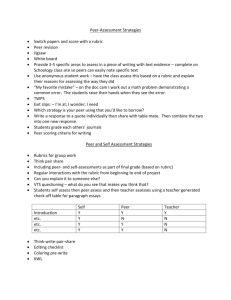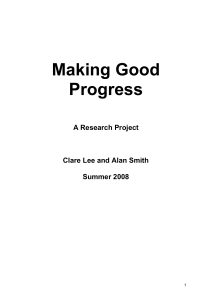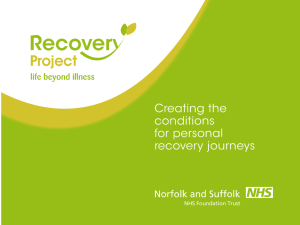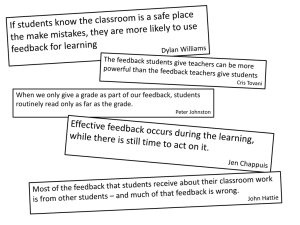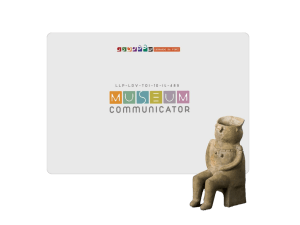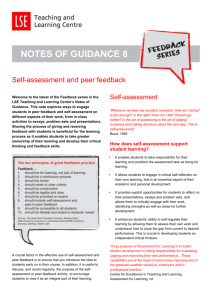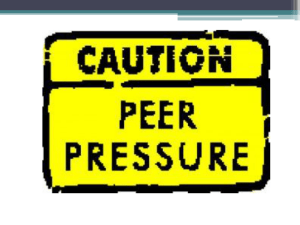Assessment-for-Learning
advertisement
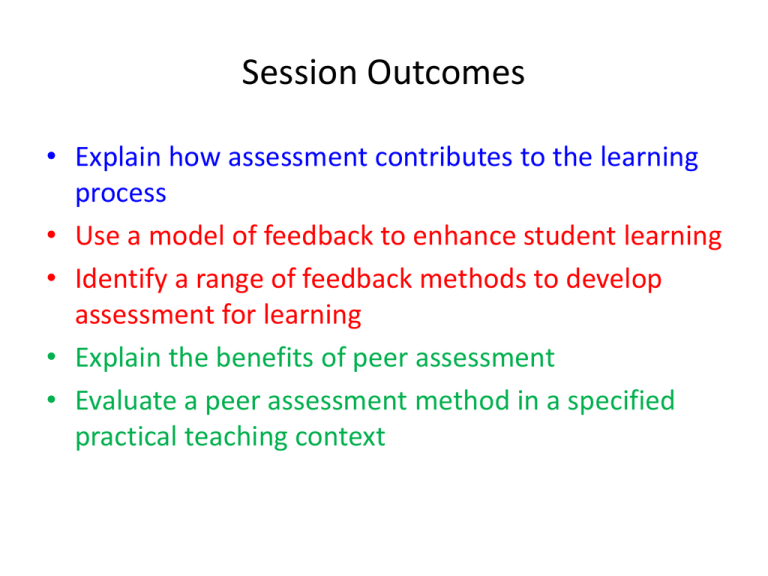
Session Outcomes • Explain how assessment contributes to the learning process • Use a model of feedback to enhance student learning • Identify a range of feedback methods to develop assessment for learning • Explain the benefits of peer assessment • Evaluate a peer assessment method in a specified practical teaching context Big Method effects on Student Attainment from Hattie’s metaanalysis (1) No. Influence Mean effect size 2 Feedback Students getting feedback on their work from the teacher or from themselves (self-assessment or from peers or some other sources). Note: some feedback has more effect than others. For example, peer assessment is 0.63 and self-assessment is 0.54 0.81 3 Whole-class interactive teaching (direct instruction) A specific approach to active learning in class, which is highly teacher led, but very active for students. This involves summaries reviews and a range of active learning methods, including questioning 0.81 4 Strategy training Explicit teaching of subject-specific and general study and thinking skills, integrated into the curriculum 0.80 11 Cooperative learning 0.59 Specific teaching methods such as jigsaw that give students responsibility for learning and teaching each other 12 Challenging goals for students 0.59 Goals that students can meet through effort on their part – they should be as specific as possible, and meaningful to the students involved Hattie’s effect sizes • Most innovations have an impact on attainment (averaging around .04), but what are the most significant one’s and how do they work? • As a baseline an effective size of 1.0 standard deviation is massive and is typically associated: – Advancing the learner’s achievement by one year – Improving the rate of learning by 50% – A two grade leap in GCSE grades • However, its important to balance effect size with level of difficulty of interventions. For example, providing ‘advance organizers’, which are summaries in advance of the teaching, has an effect size of 0.06, which is pretty average. But they only take 3 minutes at the beginning of the lesson, and yet reward us with almost a grader improvement in student’s achievement. Assessment for Learning Assessment not only provides a means to measure students knowledge , understanding and skills at a given point in time, but can (and should) be used to develop the learning process itself (formative assessment) through the provision of quality feedback Effective feedback is consistently related to students achievement. It must, as Hattie (2009) states: “...reduce discrepancies between current understandings and performance and a learning intention or goal” (p.175) In most basic terms, it identifies (then seeks to improve) the specific gaps in knowledge, skills and attitudinal components that are needed for meeting desired learning goals Assessment, therefore, is not separate from the instructional process but an integral part of it. As Perkins (1992) suggests, once considered thoughtfully: “Teaching, learning, and assessment merge into one seamless enterprise.” (p.176) Model of Feedback Learning Goal Need to reduce discrepancy between current understanding/performance and desired learning goal Teachers understanding students learning, helping them to either reframe goals and/or provide guidance on future learning options - what to do and how, etc Will typically involve finding out any of the following: • how well students understand task requirements • the processes needed to understand/perform the task • student self management of the learning process Key Points In summary, there is much of merit in the learning stakes for clear, concise and timely feedback: • • • • • • Clarify what good performance is (e.g., goals, criteria, standards) Identify gaps in performance and specific learning needs Close the gap between current and desired performance Develop the ability for self-assessment in learning Make appropriate modification of instructional strategies Promote positive beliefs and self-esteem through self-perception of mastery Feedback methods: assessment for learning • • • • • • • Peer tutoring Peer explaining One-minute paper One-minute summary Spoof assessment Peer assessment Self-assessment Examples of Questions for a One - Minute Paper • What was the most important learning point for you from this lesson? – Can also use concept, idea, etc. • What is still not clear to you from this lesson? – Can also use “muddy”, confusing, etc Why Students Must Learn to Assess Students must understand the nature and qualities of good work if they are to create it themselves. Specifically they need to know: • The meaning of key tasks language (e.g., what does ‘describe’ and ‘evaluate’ mean)? • The meaning of assessment criteria (e.g., “what does give evidence”, “show your working” mean)? • How actual tasks and criteria can be demonstrated in practice (e.g., what are acceptable evidence formats)? Model answers ( e.g., exemplars of work – very good > very poor; marking scheme) are useful to provide guidance for students in developing assessment skills Learning Benefits of Peer Assessment • Student come to understand the nature and form of good work (e.g., what learning outcomes mean at the ‘performance level’, how marks are gained and lost) • They learn other (and often) more correct ways of approaching tasks other than what they have been doing • Become more reflective (metacognitive) about their own learning, and are able to detect errors better in their own work • Student can do more work than you can mark • Student take more pride in their work when they know it is to be peer assessed • Students actually enjoy this method and develop the skills for selfassessment in the process Assignment • Prepare, conduct and evaluate a peer assessment activity for a group of students you teach. This could involve any of the peer assessment approaches outlined in the workshop session. • It is important that you get feedback from the students on their learning experience



